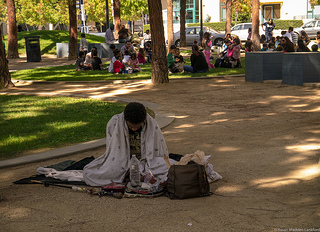The number of homeless children in the U.S. has surged in recent years to an all-time high, amounting to one child in every 30, according t o a comprehensive state-by-state report that blames the nation’s high poverty rate, the lack of affordable housing and the impacts of pervasive domestic violence.
o a comprehensive state-by-state report that blames the nation’s high poverty rate, the lack of affordable housing and the impacts of pervasive domestic violence.
- Photo by Susan Madden Lankford
Titled “America’s Youngest Outcasts,” the report just issued by the National Center on Family Homelessness calculates that nearly 2.5 million American children were homeless at some point in 2013. The number is based on the Department of Education’s latest count of 1.3 million homeless children in public schools, supplemented by estimates of homeless pre-school children not counted by the DOE.The problem is particularly severe in California, which has one-eighth of the U.S. population but accounts for more than one-fifth of the homeless children, with an estimated total of nearly 527,000.
Carmela DeCandia, director of the national center and a co-author of the report, noted that the federal government has made progress in reducing homelessness among veterans and chronically homeless adults. She said:
The same level of attention and resources has not been targeted to help families and children. As a society, therefore, we’re going to pay a high price in human and economic terms.
Child homelessness increased by 8% nationally from 2012 to 2013, according to the report, which warned of potentially devastating effects on children’s educational, emotional and social development, as well as on their parents’ health, employment prospects and parenting abilities.
The report included a composite index ranking the states on the extent of child homelessness, efforts to combat it and the overall level of child well-being. States with the best scores were Minnesota, Nebraska and Massachusetts, while at the bottom were Alabama, Mississippi and California.
Shahera Hyatt, director of the California Homeless Youth Project, claimed that the crux of the problem is the state’s high cost of living, coupled with insufficient affordable housing.
People think, ‘Of course we are not letting children and families be homeless,’ so there’s a lot of disbelief. But California has not invested in this issue.
Hyatt, 29, was homeless on and off throughout adolescence, starting when her parents were evicted when she was in 7th grade. At 15, she and her older brother took off and survived by sleeping in the tool sheds, backyards and basements of acquaintances.
She recalls:
Terms like ‘couch surfing’ and ‘doubled-up’ sound a lot more polite than they are in practice. For teenagers, it might be exchanging sex for a place to stay or staying someplace that does not feel safe because they are so mired in their day-to-day survival needs.
The new report by the National Center on Family Homelessness — a part of the private, nonprofit American Institutes for Research — says remedies for child homelessness should include an expansion of affordable housing, education and employment opportunities for homeless parents, and specialized services for the many mothers rendered homeless due to domestic violence. Efforts to obtain more resources to combat child homelessness are complicated by debate over how to quantify it.
H.U.D. conducts an annual one-day count of homeless people that encompasses shelters, as well as parks, underpasses, vacant lots and other locales. Its latest count, for a single night in January 2013, tallied 610,042 homeless people, including 130,515 children.
Defenders of H.U.D.’s method say it’s useful in identifying the homeless people most in need of urgent assistance. Critics contend that H.U.D.’s method grossly underestimates the extent of child homelessness and results in inadequate resources for local governments to combat it. They prefer the Education Department method that includes homeless families who are staying in cheap motels or doubling up temporarily in the homes of friends or relatives.
Bruce Lesley, president of the nonprofit First Focus Campaign for Children, says:
Fixing the problem starts with adopting an honest definition. Right now, these kids are sort of left out there by themselves.
Lesley’s group and some allies have endorsed a bill introduced in Congress, with bipartisan sponsorship, that would expand H.U.D.’s definition to correlate more closely with that used by the Education Department. However, the bill doesn’t propose any new spending for the hundreds of thousands of children who would be added to the H.U.D. tally.
Shahera Hyatt, of the California Homeless Youth Project, says most of the homeless schoolchildren in her state aren’t living in shelters:
It’s often one family living in extreme poverty going to live with another family that was already in extreme poverty. Kids have slept in closets and kitchens and bathrooms and other parts of the house that have not been meant for sleeping.









